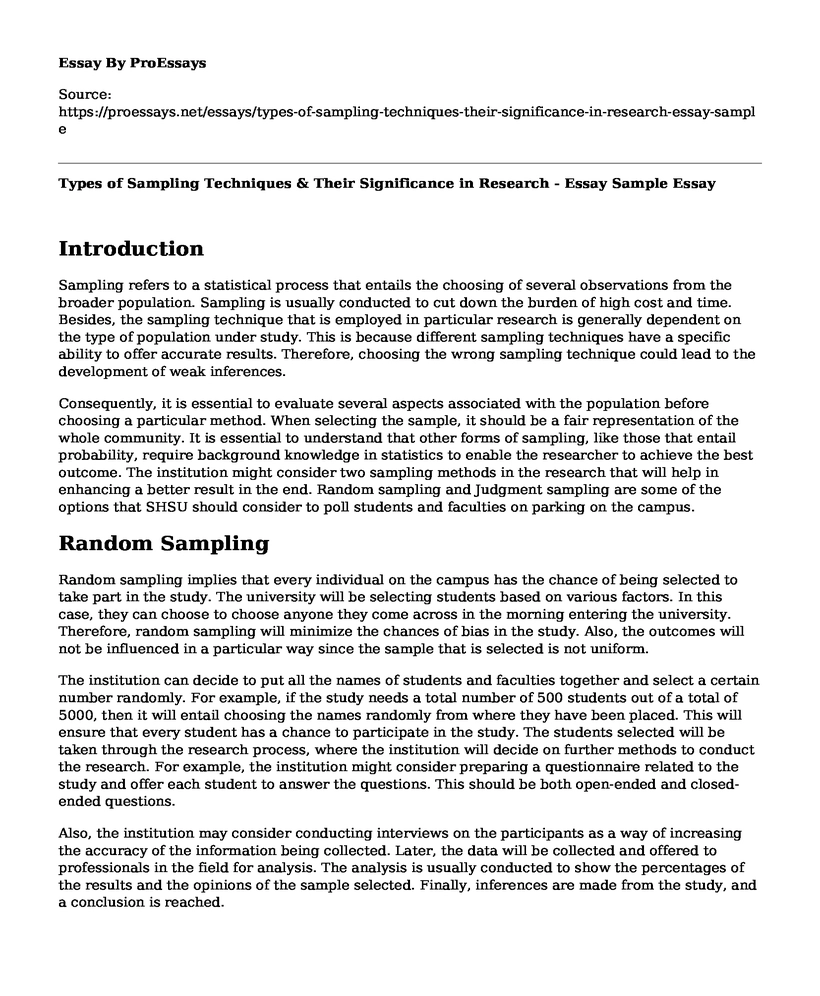Introduction
Sampling refers to a statistical process that entails the choosing of several observations from the broader population. Sampling is usually conducted to cut down the burden of high cost and time. Besides, the sampling technique that is employed in particular research is generally dependent on the type of population under study. This is because different sampling techniques have a specific ability to offer accurate results. Therefore, choosing the wrong sampling technique could lead to the development of weak inferences.
Consequently, it is essential to evaluate several aspects associated with the population before choosing a particular method. When selecting the sample, it should be a fair representation of the whole community. It is essential to understand that other forms of sampling, like those that entail probability, require background knowledge in statistics to enable the researcher to achieve the best outcome. The institution might consider two sampling methods in the research that will help in enhancing a better result in the end. Random sampling and Judgment sampling are some of the options that SHSU should consider to poll students and faculties on parking on the campus.
Random Sampling
Random sampling implies that every individual on the campus has the chance of being selected to take part in the study. The university will be selecting students based on various factors. In this case, they can choose to choose anyone they come across in the morning entering the university. Therefore, random sampling will minimize the chances of bias in the study. Also, the outcomes will not be influenced in a particular way since the sample that is selected is not uniform.
The institution can decide to put all the names of students and faculties together and select a certain number randomly. For example, if the study needs a total number of 500 students out of a total of 5000, then it will entail choosing the names randomly from where they have been placed. This will ensure that every student has a chance to participate in the study. The students selected will be taken through the research process, where the institution will decide on further methods to conduct the research. For example, the institution might consider preparing a questionnaire related to the study and offer each student to answer the questions. This should be both open-ended and closed-ended questions.
Also, the institution may consider conducting interviews on the participants as a way of increasing the accuracy of the information being collected. Later, the data will be collected and offered to professionals in the field for analysis. The analysis is usually conducted to show the percentages of the results and the opinions of the sample selected. Finally, inferences are made from the study, and a conclusion is reached.
Judgment Sampling
This entails setting up certain factors when selecting the sample. In this case, the institution team of research can decide to analyze to establish all the individuals that have used parking in the institutions. This will entail a selection of all individuals regardless of the type of motor machine that they come within the school. This will incorporate those that are using a bicycle as their means of transport to school. This method will ensure that the population from which the sample will be selected has been limited. This is because not all individuals in institutions tend to use cars, and thus to choose those that have automobiles will have its own merits and demerits. For example, one of the advantages is that the individuals selected from the population will have complete knowledge because they have used the facility before. On the other hand, this might not be efficient, considering that not all individuals have been offered an equal opportunity to participate in the study.
From the above analysis, it is clear that random sampling and judgment sampling are some of the conventional techniques that are used in research. These methods are different from each other because they follow a different procedure in the selection of the sample. This implies that employing the two approaches will not lead to similar results in the end. Therefore, it is essential to evaluate both methods to select, which is the most appropriate to be employed in the study. Thus, random sampling is far much better because it offers every student in the institution a chance to participate in the study.
On the other hand, judgment study may exclude other participants that could have offered useful information about the study. Therefore, the results that will be obtained in the random sampling are likely to be accurate because there are no chances of bias like in judgment. Therefore, as an advisor, I will consider the use of random sampling in this particular research as it will offer the institution with the right conclusions from the study. Also, the method is associated with less cost and will use less amount of time and provide a logical outcome of the study.
Cite this page
Types of Sampling Techniques & Their Significance in Research - Essay Sample. (2023, May 22). Retrieved from https://proessays.net/essays/types-of-sampling-techniques-their-significance-in-research-essay-sample
If you are the original author of this essay and no longer wish to have it published on the ProEssays website, please click below to request its removal:
- Hypothesis, Theory and Variables Essay
- Strategic and Financial Performance and Position of Gamuda Berhad, a Malaysian Engineering Company
- Qualitative Research in Nursing Discussion Board
- Structural Equation Modeling and AMOS Paper Example
- Appraisal of the Methods Used for a Qualitative Study - Essay Sample
- IKEA Brand Scorecard Paper Example
- Types of Sampling Techniques & Their Significance in Research - Essay Sample







